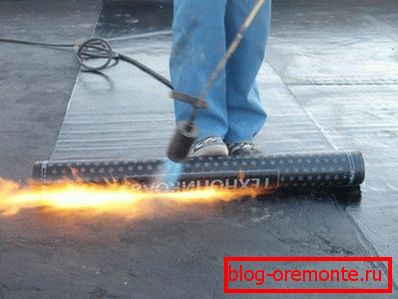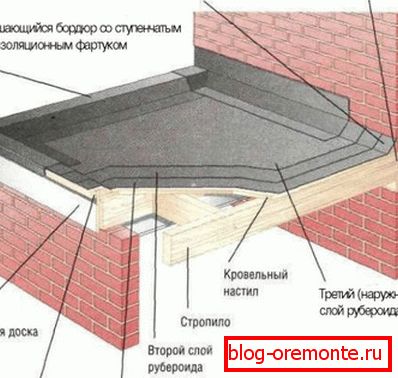How to repair the roof with roofing paper with your own
Roofing material for overlapping roof began to produce more than 100 years ago, but over the years it has not lost its relevance. This material is valued for its availability, cheapness and resistance to moisture. However, the roof with a ruberoid coating is subject to mechanical stress, therefore, often requires repair. Therefore, homeowners regularly face the question of how to repair a roof of roofing material. Since this material belongs to the "economy" class, it is inappropriate to involve in the process of reconstruction of professional roofers, it is more rational to do it yourself. In this article we will explain why there are leaks in the ruberoid coating, as well as how to fix these gaps with your own hands.
Material characteristics and causes of leaks
Roofing material - deposited material on the basis of roofing paperboard, impregnated with oil bitumen, with mineral dressing. For the production using thick cardboard thickness of 200-420 g / m2. More modern and technological analogues are made of fiberglass or polyester. Water resistance, resistance to ultraviolet and microorganisms that cause decay and the formation of fungus, make the coating of roofing material super reliable. Laying material is overlapped in several layers, which provides excellent waterproofing. Installation is performed by fusing, some types of roofing material glue the material with molten bitumen or special mastic. Leaks in such a coating appear for the following reasons:
- Incorrect use. Manufacturers of roofing material do not recommend the use of this material on existing roofs, as when people are on this surface mechanical damage may occur, leading to leakage. However, developers often ignore manufacturers' warnings due to cheap roofing material.
- Atmospheric effects. The water falling on the roof of roofing material is absorbed in a small amount into the roofing material, and then when it freezes, it crystallizes, leading to the formation of cracks.
- Wind load. In regions with a high wind load, the ruberoid is damaged by sharp, strong gusts.
- Wrong installation. The most common cause of leakage of the ruberoid roof is poor installation of the material, made without complying with the recommended technology. In particular, non-observance of overlaps between the bands or poor preparation of the base of the blood can cause problems.
- Poor quality material. The second most common cause of leaks in roofs with a ruberoid coating is considered the use of low-quality, cheap material.


Note! The lifetime of the cheaper lining roofing material, which is used for laying the inner layers of the roofing pie, is only 5 years. Roof stamps are more expensive, but serve about 7-8 years. Since the coating consists of several layers of material, the total duration without the repair period of the roofs of this design is 10-15 years.
Types of repair work
Each type of roofing material has its own shelf life, after which small cracks and defects are formed in the roof covering, and then a full leak. Roofing material stacks overlapped in 3-6 layers, which helps to extend the use of the material up to 15 years at best. The most common "diseases" of this coating are cracks, breakouts and blisters. With their own hands, they eliminate these defects in the following ways:
- Patch repair When minor damage is formed on the roofs of their roofing material, patch repair is carried out. He is to seal the defects with his own hands with new layers of roofing material of a small area. The complexity of this method is that the stone chips, which are sprinkled on the top layer of roofing material, reduces adhesion, and thus prevents adhesion. Installing patches is inexpensive and can extend the operation of the roof for 1-2 seasons, but this will only slightly delay the overhaul.


- Repair without removing the cover. If there are a lot of defects on the surface of the material, but there are no blisters, and there is no water in the thickness of the roofing pie, they do the flooring with their own hands without removing the old one. To do this, the protective crumb is removed from the surface of the top layer of roofing material, it is treated with bitumen mastic to improve adhesion, and then 1-2 layers of roofing are deposited or glued.

- Repair with the removal of the old coating. If the roofing roof is operated without repair for more than 15 years, and on the surface of the material there is a through damage, swelling, one patch repair or a new floor covering can not be dismantled. In this case, experienced roofers recommend dismantling the old roof to the ground, and then lay a new roofing felt. This task can be done with your own hands, if you perform installation by gluing or rent a gas torch for fusing.

Important! According to the experience of professional roofing masters, it makes sense to repair a ruberoid coating without removing old layers, if the total damage area on the roof surface does not exceed 10-15%.
Roof repair without removing the cover
The roof of roofing material, made in the times of the USSR and complying with strict quality standards, is highly reliable, but in our time it is already serving its age. Due to the inexpensive price and ease of installation of this material, it has become a popular construction solution for the overlap of country or garden houses, industrial buildings, outbuildings. You can repair the roof of roofing material with your own hands, if you act on the following technology:
- First of all, they carry out a thorough revision of the surface of the roof slope and the truss frame of the roof. If they are in satisfactory condition, you can repair it without removing the old coating. If the rafters are damaged, the dismantling of the entire roof structure cannot be avoided.
- Old roofing is cleaned of debris, dust and dirt. To do this, use water and a brush with soft plastic bristles.
- Where there are bulges on the roof surface, it is necessary to make shallow cruciate cuts, and then squeeze out the accumulated moisture from under the roofing material.
- Next, the roof is left to dry. If the weather is dry and warm, the moisture will evaporate in 2-3 days. If the weather is wet or the volume of accumulated liquid is large enough, use a building dryer.
- To increase the adhesion between the old and the new coating, stone chips are scraped off the top layer of roofing material and then ground with bitumen mastic.
- After drying, the mastic begins laying new roofing material. Roofing material is cut into strips, and then fused or glued to the old coating with an overlap of 15-25 cm. Mount 3-5 layers, arranging vrazbezhku so that the joints between the material do not match.


Professional roofers note the importance of observing overlaps between the strips of roofing material. The ruberoid after the end of the installation gives a significant shrinkage, which is why the bands can simply diverge, forming a gap in the joints. The smaller the slope of the roof, the more do overlap.